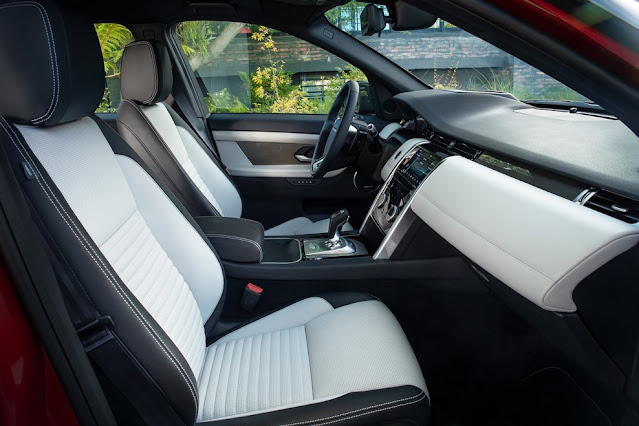Land Rover Discovery Sport road test by Steve Rogers
So, you would like
a new Range Rover but 80 grand is too salty for the pocket.
Solution. Troll the
second hand market, or maybe there's a better option... buy a new Discovery
Sport.
This is as close as
you can get to the big man without paying the big bucks, although you'll still
need £45-£50,000 to get near that real feeling of luxury.
Discovery Sport
first appeared at the end of 2014 replacing Freelander which was nothing like a
Range Rover. The aim was to distance the Land Rover brand from the growing crop
of SUVs and it has been a roaring success winning awards left right and centre and
becoming more a part of the 'if only I had the money' Range Rover family.
It has been
freshened up with new light designs front and back, along with upgraded engines
and even more technology.
Petrol and diesel
engines now have mild hybrid electric motors to harvest battery power under
braking. This shaves gramms off emissions and gives a small lift to economy but
it does not mean you can drive on pure electric.
The tech team has
built a whole new infotainment system called Pivi which does so much I got
bored going through it all, but being able to pair two smart phones at the same
time is a bonus although the most impressive new feature is 'over the air'
software updates which saves going to the garage and waiting an age for the
latest navigation maps to be downloaded and such like.
Dashboard layout is
unchanged so you still get the problem of the sun blocking out the screen at
certain times of the day. It only happened once as the sun was hardly out
during my week with the car but something to consider at the next big redesign.
For the most part
the cabin with its quality trim is a classy, comfortable place to be, just
don't think you are in Range Rover territory. It is a big car with lashings of
space for five adults and, unlike most of its rivals, provides an extra two
foldaway seats although they are best suited to young children.
Seven up obviously
dramatically reduces boot space but sticking to five leaves a huge area and
with all the back seats down a couple can happily sleep in the car. There is a
good amount of casual storage space and seven USB sockets which will come in
handy when it's a full house.
Disco Sport is a popular
tow car with additional safety features to keep the van on the straight and
narrow. I endured some big winds towing my 7.2 metre caravan but never felt
troubled and you can keep an eye on the van on the move thanks to the surround
camera system. The 'disappearing' tow bar can be deployed from the touchscreen
and if you can be bothered to put in the trailer dimensions it will park it as
well.
My wife won the
towing economy challenge returning 25.3mpg over 160 miles, a decent return from
a 200hp 2-litre diesel. Most of the towing was motorway which was the right
territory for the nine speed auto box. We even managed 42mpg on a 100 mile solo
drive.
Although it pulls
strongly the Disco doesn't feel quick off the mark and is tuned more to comfort
as opposed to the stiffer ride of an Audi or BMW so expect some rolling through
bends.
Where it beats
everyone is its off road credentials. How often will they be needed? Probably
rarely but I know which car I would choose in a mud fight! It will even wade
through 600mm if water, that's nearly as high as the average office desk.
The entry front
wheel drive Discovery Sport is around £32,000 but realistically you need to
push the boat out to soak up the luxury. My HSE was just over £52k with extras and
was packed with the things we love as well as a full suite of safety features.
It is not a Range
Rover or Audi Q8 but the Disco Sport has enough grandeur to at least make you
think you are lording it.
Fast facts
Discovery Sport
D200 HSE 9sp auto
£46,815
2-litre turbo
diesel; 204bhp
0-62mph 8.9secs;
117mph
41.4mpg combined
179g/km. 1st VED
£1,305
Insurance group 33
Towing capacity
2,500kg








